2002 LINCOLN CONTINENTAL brakes
[x] Cancel search: brakesPage 144 of 240
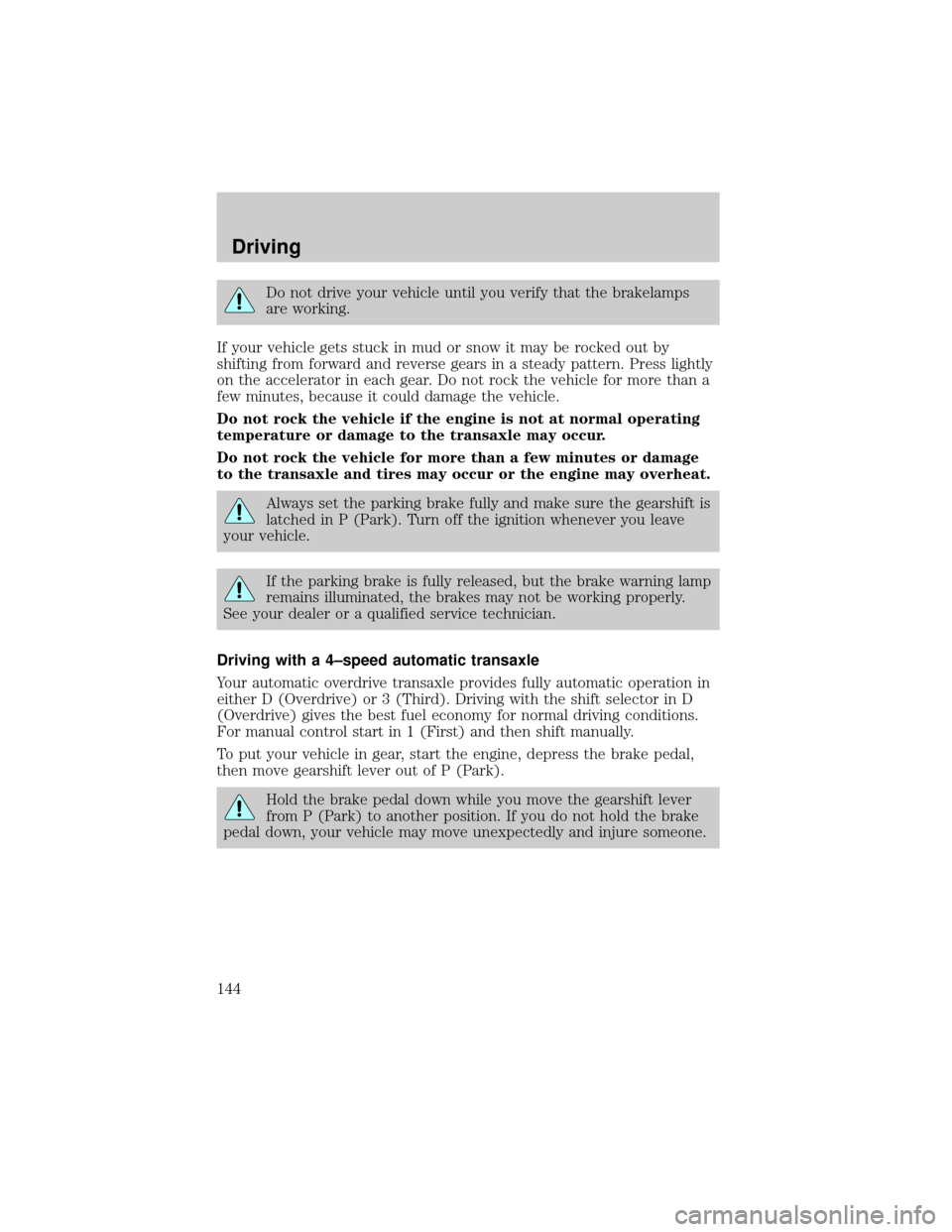
Do not drive your vehicle until you verify that the brakelamps
are working.
If your vehicle gets stuck in mud or snow it may be rocked out by
shifting from forward and reverse gears in a steady pattern. Press lightly
on the accelerator in each gear. Do not rock the vehicle for more than a
few minutes, because it could damage the vehicle.
Do not rock the vehicle if the engine is not at normal operating
temperature or damage to the transaxle may occur.
Do not rock the vehicle for more than a few minutes or damage
to the transaxle and tires may occur or the engine may overheat.
Always set the parking brake fully and make sure the gearshift is
latched in P (Park). Turn off the ignition whenever you leave
your vehicle.
If the parking brake is fully released, but the brake warning lamp
remains illuminated, the brakes may not be working properly.
See your dealer or a qualified service technician.
Driving with a 4±speed automatic transaxle
Your automatic overdrive transaxle provides fully automatic operation in
either D (Overdrive) or 3 (Third). Driving with the shift selector in D
(Overdrive) gives the best fuel economy for normal driving conditions.
For manual control start in 1 (First) and then shift manually.
To put your vehicle in gear, start the engine, depress the brake pedal,
then move gearshift lever out of P (Park).
Hold the brake pedal down while you move the gearshift lever
from P (Park) to another position. If you do not hold the brake
pedal down, your vehicle may move unexpectedly and injure someone.
Driving
144
Page 148 of 240
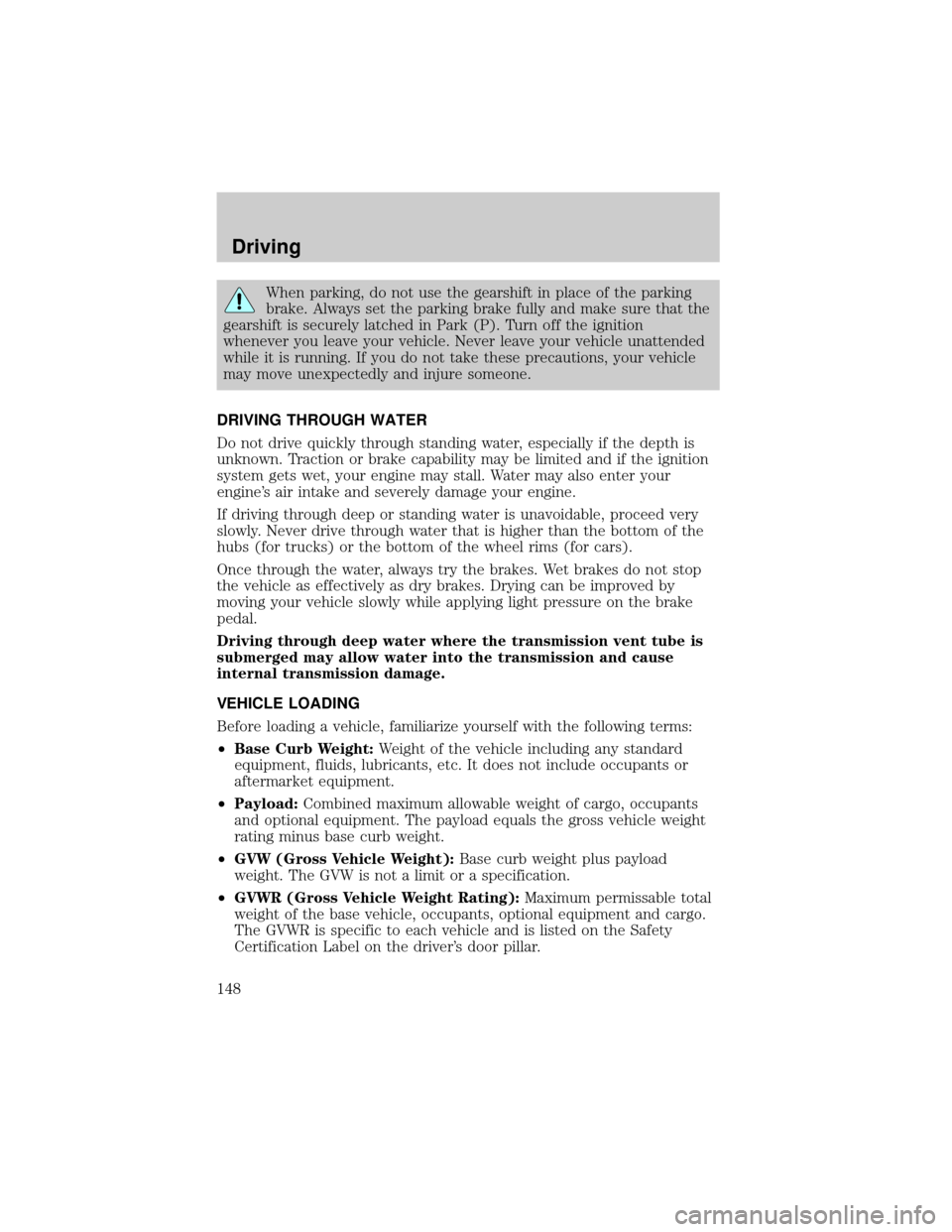
When parking, do not use the gearshift in place of the parking
brake. Always set the parking brake fully and make sure that the
gearshift is securely latched in Park (P). Turn off the ignition
whenever you leave your vehicle. Never leave your vehicle unattended
while it is running. If you do not take these precautions, your vehicle
may move unexpectedly and injure someone.
DRIVING THROUGH WATER
Do not drive quickly through standing water, especially if the depth is
unknown. Traction or brake capability may be limited and if the ignition
system gets wet, your engine may stall. Water may also enter your
engine's air intake and severely damage your engine.
If driving through deep or standing water is unavoidable, proceed very
slowly. Never drive through water that is higher than the bottom of the
hubs (for trucks) or the bottom of the wheel rims (for cars).
Once through the water, always try the brakes. Wet brakes do not stop
the vehicle as effectively as dry brakes. Drying can be improved by
moving your vehicle slowly while applying light pressure on the brake
pedal.
Driving through deep water where the transmission vent tube is
submerged may allow water into the transmission and cause
internal transmission damage.
VEHICLE LOADING
Before loading a vehicle, familiarize yourself with the following terms:
²Base Curb Weight:Weight of the vehicle including any standard
equipment, fluids, lubricants, etc. It does not include occupants or
aftermarket equipment.
²Payload:Combined maximum allowable weight of cargo, occupants
and optional equipment. The payload equals the gross vehicle weight
rating minus base curb weight.
²GVW (Gross Vehicle Weight):Base curb weight plus payload
weight. The GVW is not a limit or a specification.
²GVWR (Gross Vehicle Weight Rating):Maximum permissable total
weight of the base vehicle, occupants, optional equipment and cargo.
The GVWR is specific to each vehicle and is listed on the Safety
Certification Label on the driver's door pillar.
Driving
148
Page 150 of 240
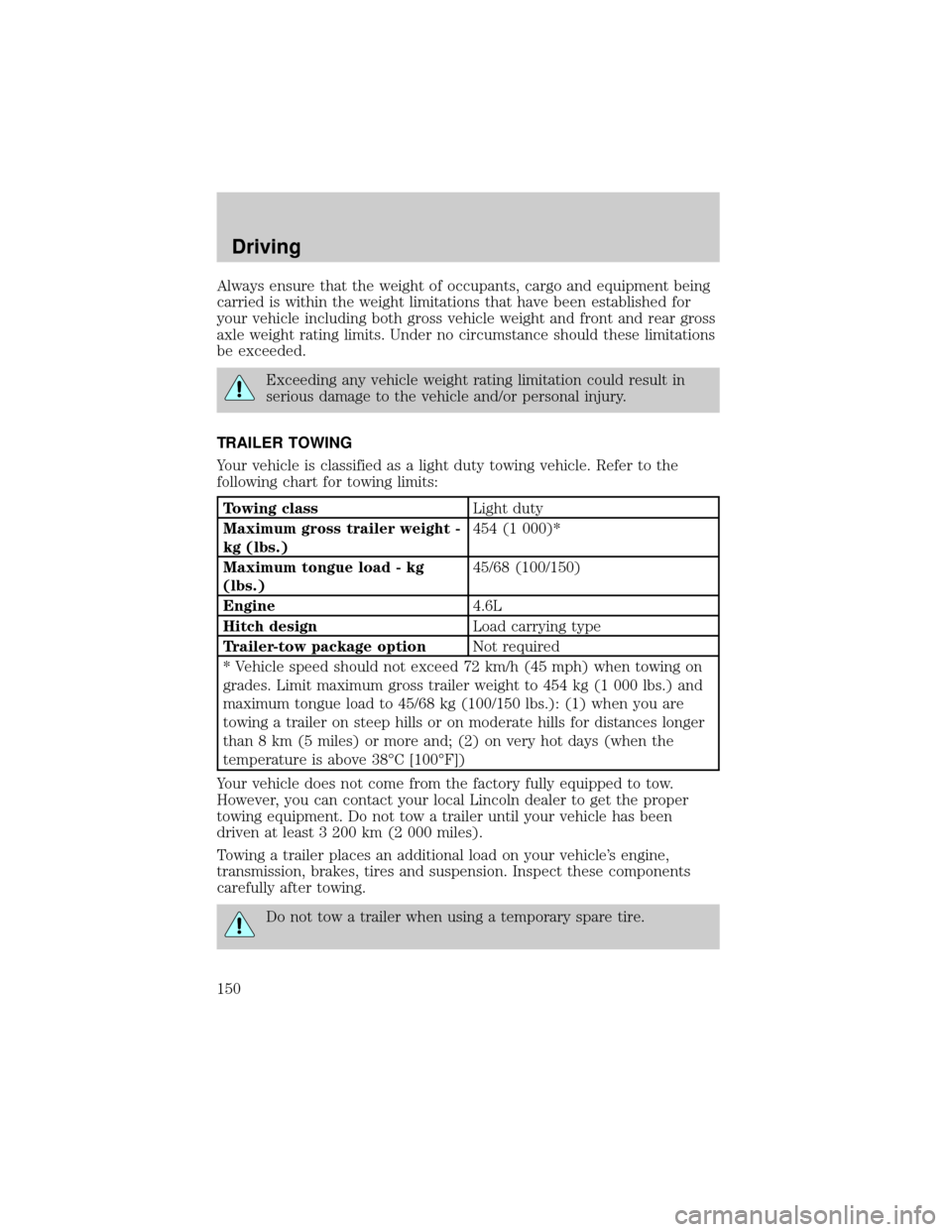
Always ensure that the weight of occupants, cargo and equipment being
carried is within the weight limitations that have been established for
your vehicle including both gross vehicle weight and front and rear gross
axle weight rating limits. Under no circumstance should these limitations
be exceeded.
Exceeding any vehicle weight rating limitation could result in
serious damage to the vehicle and/or personal injury.
TRAILER TOWING
Your vehicle is classified as a light duty towing vehicle. Refer to the
following chart for towing limits:
Towing classLight duty
Maximum gross trailer weight -
kg (lbs.)454 (1 000)*
Maximum tongue load - kg
(lbs.)45/68 (100/150)
Engine4.6L
Hitch designLoad carrying type
Trailer-tow package optionNot required
* Vehicle speed should not exceed 72 km/h (45 mph) when towing on
grades. Limit maximum gross trailer weight to 454 kg (1 000 lbs.) and
maximum tongue load to 45/68 kg (100/150 lbs.): (1) when you are
towing a trailer on steep hills or on moderate hills for distances longer
than 8 km (5 miles) or more and; (2) on very hot days (when the
temperature is above 38ÉC [100ÉF])
Your vehicle does not come from the factory fully equipped to tow.
However, you can contact your local Lincoln dealer to get the proper
towing equipment. Do not tow a trailer until your vehicle has been
driven at least 3 200 km (2 000 miles).
Towing a trailer places an additional load on your vehicle's engine,
transmission, brakes, tires and suspension. Inspect these components
carefully after towing.
Do not tow a trailer when using a temporary spare tire.
Driving
150
Page 151 of 240
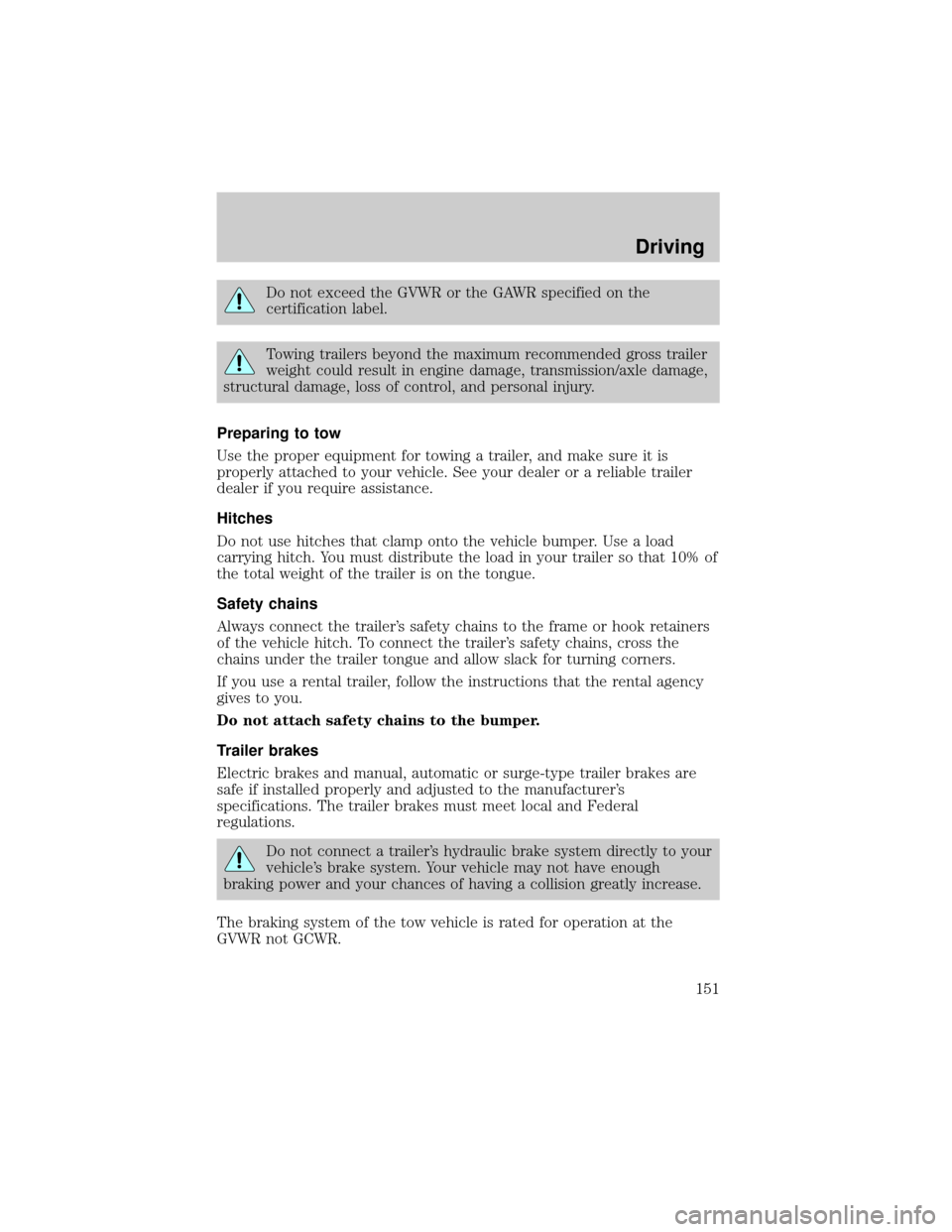
Do not exceed the GVWR or the GAWR specified on the
certification label.
Towing trailers beyond the maximum recommended gross trailer
weight could result in engine damage, transmission/axle damage,
structural damage, loss of control, and personal injury.
Preparing to tow
Use the proper equipment for towing a trailer, and make sure it is
properly attached to your vehicle. See your dealer or a reliable trailer
dealer if you require assistance.
Hitches
Do not use hitches that clamp onto the vehicle bumper. Use a load
carrying hitch. You must distribute the load in your trailer so that 10% of
the total weight of the trailer is on the tongue.
Safety chains
Always connect the trailer's safety chains to the frame or hook retainers
of the vehicle hitch. To connect the trailer's safety chains, cross the
chains under the trailer tongue and allow slack for turning corners.
If you use a rental trailer, follow the instructions that the rental agency
gives to you.
Do not attach safety chains to the bumper.
Trailer brakes
Electric brakes and manual, automatic or surge-type trailer brakes are
safe if installed properly and adjusted to the manufacturer's
specifications. The trailer brakes must meet local and Federal
regulations.
Do not connect a trailer's hydraulic brake system directly to your
vehicle's brake system. Your vehicle may not have enough
braking power and your chances of having a collision greatly increase.
The braking system of the tow vehicle is rated for operation at the
GVWR not GCWR.
Driving
151
Page 152 of 240

Trailer lamps
Do not connect a trailer's lighting system directly to your vehicle's
lighting system. To get the proper equipment for hooking up your
trailer's lamps, see your Lincoln Mercury dealer. Be sure to follow their
instructions carefully.
If you do not install trailer lights correctly, you may cause damage to the
vehicle's lighting system or other vehicle systems.
Driving while you tow
When towing a trailer:
²Ensure that you turn off your speed control. The speed control may
shut off automatically when you are towing on long, steep grades.
²Consult your local motor vehicle speed regulations for towing a trailer.
²Shift out of D (Overdrive) and into 3 (Third) or a lower gear when
towing up or down steep hills. This will eliminate excessive
downshifting and upshifting for optimum fuel economy and transaxle
cooling.
²Anticipate stops and brake gradually.
Servicing after towing
If you tow a trailer for long distances, your vehicle will require more
frequent service intervals. Refer to your scheduled maintenance guide for
more information.
Trailer towing tips
²Practice turning, stopping and backing up before starting on a trip to
get the feel of the vehicle trailer combination. When turning, make
wider turns so the trailer wheels will clear curbs and other obstacles.
²Allow more distance for stopping with a trailer attached.
²If you are driving down a long or steep hill, shift to a lower gear. Do
not apply the brakes continuously, as they may overheat and become
less effective.
²The trailer tongue weight should be 10% of the loaded trailer weight.
²After you have traveled 80 km (50 miles), thoroughly check your
hitch, electrical connections and trailer wheel lug nuts.
Driving
152
Page 215 of 240
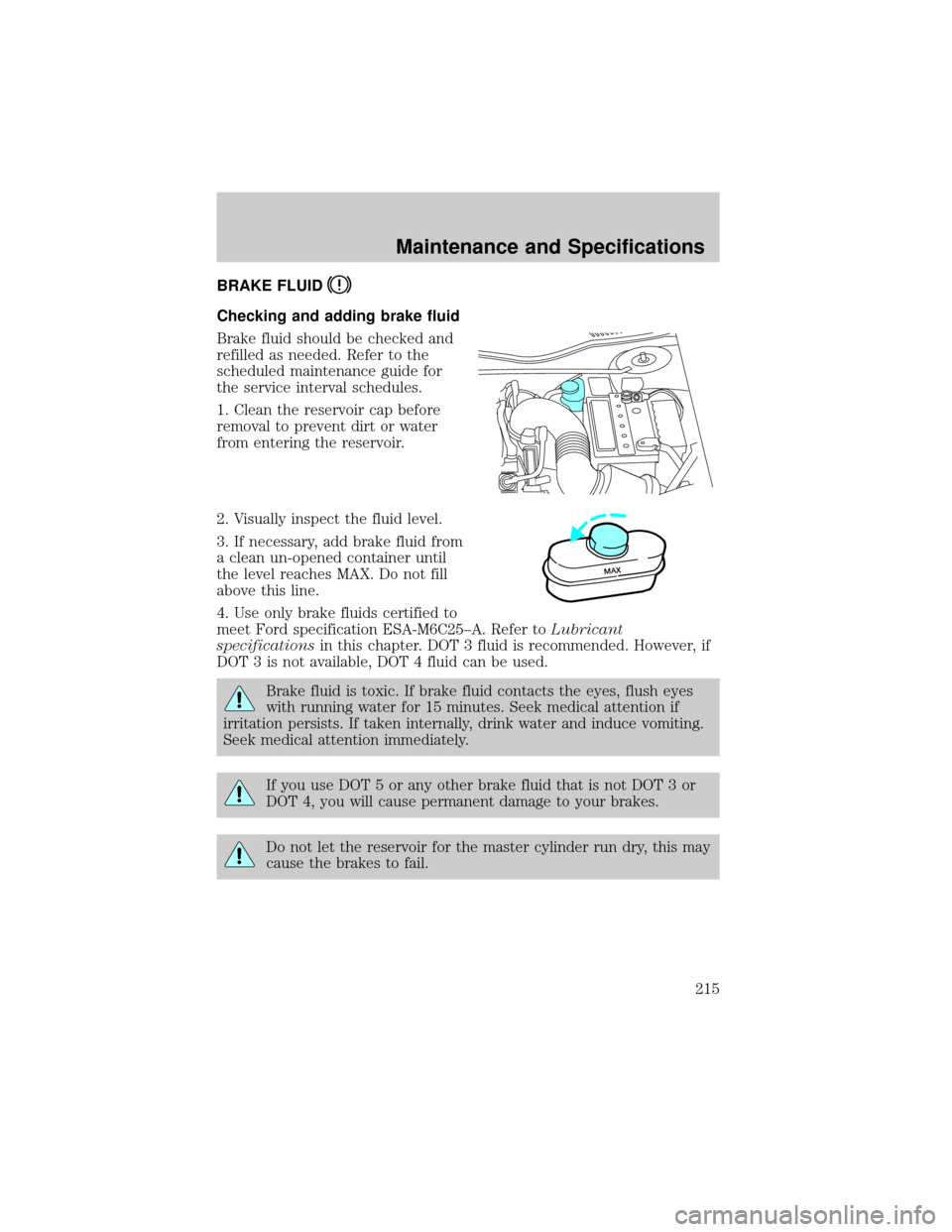
BRAKE FLUID
Checking and adding brake fluid
Brake fluid should be checked and
refilled as needed. Refer to the
scheduled maintenance guide for
the service interval schedules.
1. Clean the reservoir cap before
removal to prevent dirt or water
from entering the reservoir.
2. Visually inspect the fluid level.
3. If necessary, add brake fluid from
a clean un-opened container until
the level reaches MAX. Do not fill
above this line.
4. Use only brake fluids certified to
meet Ford specification ESA-M6C25±A. Refer toLubricant
specificationsin this chapter. DOT 3 fluid is recommended. However, if
DOT 3 is not available, DOT 4 fluid can be used.
Brake fluid is toxic. If brake fluid contacts the eyes, flush eyes
with running water for 15 minutes. Seek medical attention if
irritation persists. If taken internally, drink water and induce vomiting.
Seek medical attention immediately.
If you use DOT 5 or any other brake fluid that is not DOT 3 or
DOT 4, you will cause permanent damage to your brakes.
Do not let the reservoir for the master cylinder run dry, this may
cause the brakes to fail.
MAX
Maintenance and Specifications
215
Page 234 of 240

A
Accessory delay ..........................58
Air bag supplemental restraint
system ................................117, 122
and child safety seats ............119
description ......................117, 122
disposal ....................................125
driver air bag ..................120, 123
indicator light ...........12, 121, 124
operation .........................120, 123
passenger air bag ...........120, 123
side air bag ..............................122
Air cleaner filter .......................224
Air conditioning ..........................33
Air filter, cabin ............................39
Air suspension ...........................142
description ..............................142
Antifreeze (see Engine
coolant) .....................................199
Anti-lock brake system (see
Brakes) ..............................138±139
Anti-theft system ......................101
arming the system ..................101
disarming a triggered
system .....................................102
Automatic transaxle .................143
driving with .............................145
fluid, adding ............................216
fluid, checking ........................216
fluid, refill capacities ..............224
fluid, specification ..................227
Auxiliary power point ...........55±56
Axle
lubricant specifications ..........226B
Battery .......................................197
acid, treating emergencies .....197
charging system warning light 12
jumping a disabled battery ....167
maintenance-free ....................197
replacement, specifications ...224
servicing ..................................197
Belt minder ...............................112
Brakes ........................................138
anti-lock ...........................138±139
anti-lock brake system (ABS)
warning light .....................11, 139
brake warning light ..................11
fluid, checking and adding ....215
fluid, refill capacities ..............224
fluid, specifications .........226±227
lubricant specifications ..226±227
shift interlock ..........................143
Break-in period .............................6
C
Capacities for refilling fluids ....224
CD changer .................................28
Certification Label ....................229
Child safety restraints ..............125
child safety belts ....................125
Child safety seats ......................126
attaching with tether straps ..130
in front seat ............................128
in rear seat ..............................128
Cleaning your vehicle
engine compartment ..............186
exterior ....................................189
instrument cluster lens ..........188
instrument panel ....................187
interior .....................................188
Index
234
Page 237 of 240

Hood ..........................................192
I
Ignition ...............................133, 227
Infant seats (see Safety
seats) .........................................126
Inspection/maintenance (I/M)
testing ........................................213
Instrument panel
cleaning ...................................187
cluster ................................10, 188
lighting up panel and
interior .......................................41
J
Jack ............................................163
positioning ...............................163
storage .....................................163
Jump-starting your vehicle ......167
K
Keyless entry system .................94
autolock .....................................97
keypad .......................................94
programming entry code .........95
Keys .........................87, 97±98, 100
key in ignition chime ...............14
positions of the ignition .........133
L
Lamps
autolamp system .......................41
bulb replacement
specifications chart ..................46
cargo lamps ...............................41
daytime running light ...............40headlamps .................................40
headlamps, flash to pass ..........41
instrument panel, dimming .....41
interior lamps .....................45, 47
replacing bulbs ....... 46±47, 49±52
Lane change indicator (see
Turn signal) .................................44
Lights, warning and indicator ....10
air bag ........................................12
anti-lock brakes (ABS) ....11, 139
brake ..........................................11
charging system ........................12
high beam .................................13
oil pressure ...............................12
safety belt .................................12
service engine soon ..................10
traction control active ..............12
turn signal indicator .................13
Load limits .................................148
GAWR ......................................148
GVWR ......................................148
trailer towing ..........................148
Locks
autolock .....................................97
childproof ..................................87
doors ..........................................87
Lubricant specifications ...226±227
Lug nuts, anti-theft ...................166
Lumbar support, seats .............105
M
Message center ...............76, 78, 84
air leveling disabled .................76
air ride switch off .....................76
check air ride system ...............76
check air suspension ................76
menu button .............................83
reset button ..............................84
Index
237